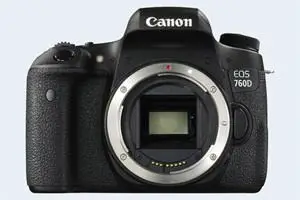Canon 760D vs G7X Mark III
The Canon EOS 760D (called Canon T6s in some regions) and the Canon PowerShot G7 X Mark III are two digital cameras that were announced, respectively, in February 2015 and July 2019. The 760D is a DSLR, while the G7X Mark III is a fixed lens compact. The cameras are based on an APS-C (760D) and an one-inch (G7X Mark III) sensor. The 760D has a resolution of 24 megapixels, whereas the G7X Mark III provides 20 MP.
Below is an overview of the main specs of the two cameras as a starting point for the comparison.

Check 760D offers at
ebay.com

Check G7X Mark III price at
amazon.com
Going beyond this snapshot of core features and characteristics, what are the differences between the Canon EOS 760D and the Canon PowerShot G7 X Mark III? Which one should you buy? Read on to find out how these two cameras compare with respect to their body size, their imaging sensors, their shooting features, their input-output connections, and their reception by expert reviewers.
Body comparison
The side-by-side display below illustrates the physical size and weight of the Canon 760D and the Canon G7 X Mark III. The two cameras are presented according to their relative size. Three successive views from the front, the top, and the rear are shown. All width, height and depth measures are rounded to the nearest millimeter.
The G7X Mark III can be obtained in two different colors (black, silver), while the 760D is only available in black.
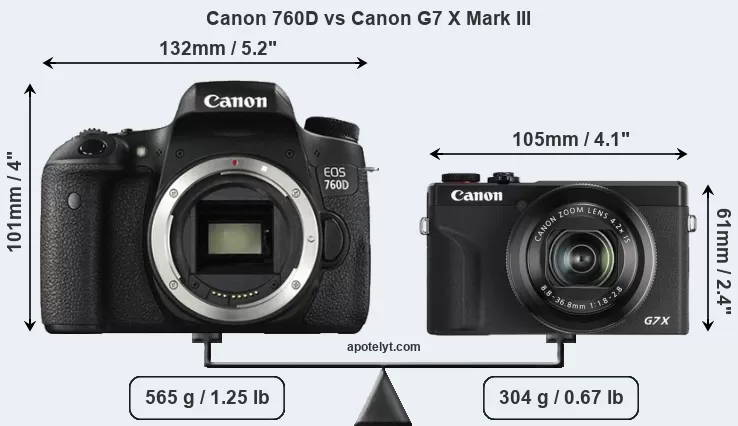
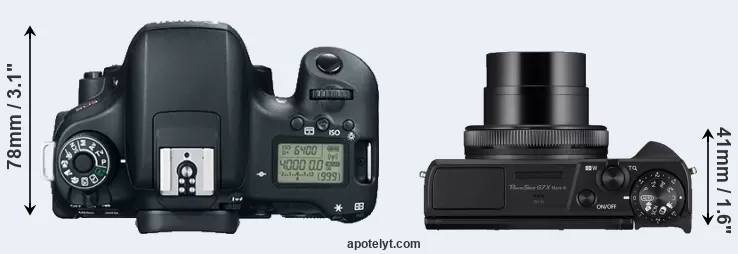
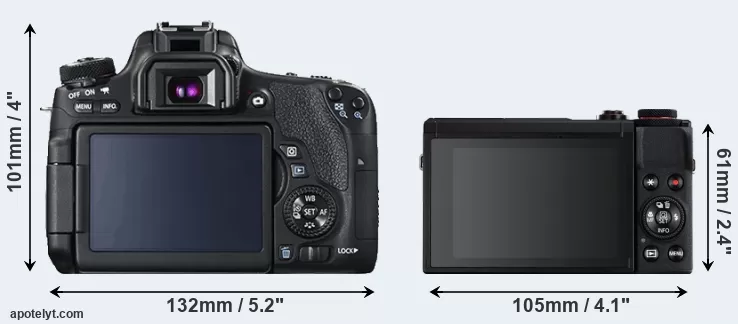
If the front view area (width x height) of the cameras is taken as an aggregate measure of their size, the Canon G7 X Mark III is considerably smaller (52 percent) than the Canon 760D. In this context, it is worth noting that neither the 760D nor the G7X Mark III are weather-sealed.
The above size and weight comparisons are to some extent incomplete and possibly misleading, as the G7X Mark III has a lens built in, whereas the 760D is an interchangeable lens camera that requires a separate lens. Attaching the latter will add extra weight and bulk to the setup. You can compare the optics available for the 760D and their specifications in the Canon EF Lens Catalog.
Concerning battery life, the 760D gets 440 shots out of its Canon LP-E17 battery, while the G7X Mark III can take 235 images on a single charge of its Canon NB-13L power pack. The power pack in the G7X Mark III can be charged via the USB port, which can be very convenient when travelling.
The adjacent table lists the principal physical characteristics of the two cameras alongside a wider set of alternatives. If you would like to visualize and compare a different camera combination, you can navigate to the CAM-parator app and make your selection from a broad list of cameras there.

| Camera Model |
Camera Width |
Camera Height |
Camera Depth |
Camera Weight |
Battery Life |
Weather Sealing |
Camera Launch |
Launch Price (USD) |
Street Price |
||
|---|---|---|---|---|---|---|---|---|---|---|---|
| 1. | Canon 760D | 132 mm | 101 mm | 78 mm | 565 g | 440 | n | Feb 2015 | 649 | ebay.com | |
| 2. | Canon G7 X Mark III | 105 mm | 61 mm | 41 mm | 304 g | 235 | n | Jul 2019 | 749 | amazon.com | |
| 3. | Canon 77D | 131 mm | 100 mm | 76 mm | 540 g | 600 | n | Feb 2017 | 899 | ebay.com | |
| 4. | Canon 650D | 133 mm | 100 mm | 79 mm | 575 g | 440 | n | Jun 2012 | 849 | ebay.com | |
| 5. | Canon 750D | 132 mm | 101 mm | 78 mm | 555 g | 440 | n | Feb 2015 | 749 | ebay.com | |
| 6. | Canon 800D | 131 mm | 100 mm | 76 mm | 532 g | 600 | n | Feb 2017 | 749 | ebay.com | |
| 7. | Canon 1200D | 130 mm | 100 mm | 78 mm | 480 g | 500 | n | Feb 2014 | 449 | ebay.com | |
| 8. | Canon 2000D | 129 mm | 101 mm | 78 mm | 475 g | 500 | n | Feb 2018 | 449 | amazon.com | |
| 9. | Canon G1 X Mark II | 116 mm | 74 mm | 66 mm | 553 g | 240 | n | Feb 2014 | 799 | ebay.com | |
| 10. | Canon G5 X | 112 mm | 76 mm | 44 mm | 353 g | 210 | n | Oct 2015 | 799 | ebay.com | |
| 11. | Canon G5 X Mark II | 111 mm | 61 mm | 46 mm | 340 g | 230 | n | Jul 2019 | 899 | ebay.com | |
| 12. | Canon G7 X | 103 mm | 60 mm | 40 mm | 304 g | 210 | n | Sep 2014 | 699 | ebay.com | |
| 13. | Canon G7 X Mark II | 106 mm | 61 mm | 42 mm | 319 g | 265 | n | Feb 2016 | 699 | ebay.com | |
| 14. | Canon M5 | 116 mm | 89 mm | 61 mm | 427 g | 295 | n | Sep 2016 | 979 | ebay.com | |
| 15. | Canon SX740 | 110 mm | 64 mm | 40 mm | 299 g | 265 | n | Jul 2018 | 399 | amazon.com | |
| 16. | Nikon D5600 | 124 mm | 97 mm | 70 mm | 465 g | 970 | n | Nov 2016 | 699 | ebay.com | |
| Note: Measurements and pricing do not include easily detachable parts, such as add-on or interchangeable lenses or optional viewfinders. | |||||||||||
Any camera decision will naturally be influenced heavily by the price. The listed launch prices provide an indication of the market segment that the manufacturer of the cameras have been targeting. Usually, retail prices stay at first close to the launch price, but after several months, discounts become available. Later in the product cycle and, in particular, when the replacement model is about to appear, further discounting and stock clearance sales often push the camera price considerably down.
Sensor comparison
The imaging sensor is at the core of digital cameras and its size is one of the main determining factors of image quality. A large sensor will tend to have larger individual pixels that provide better low-light sensitivity, wider dynamic range, and richer color-depth than smaller pixel-units in a sensor of the same technological generation. Moreover, a large sensor camera will give the photographer more control over depth-of-field in the image and, thus, the ability to better isolate a subject from the background. On the downside, larger sensors tend to be associated with larger, more expensive camera bodies and lenses.
Of the two cameras under consideration, the Canon 760D features an APS-C sensor and the Canon G7 X Mark III an one-inch sensor. The sensor area in the G7X Mark III is 65 percent smaller. As a result of these sensor size differences, the cameras have a format factor of, respectively, 1.6 and 2.7. Both cameras have a native aspect ratio (sensor width to sensor height) of 3:2.
Technology-wise, the G7X Mark III uses a more advanced image processing engine (DIGIC 8) than the 760D (DIGIC 6), with benefits for noise reduction, color accuracy, and processing speed.
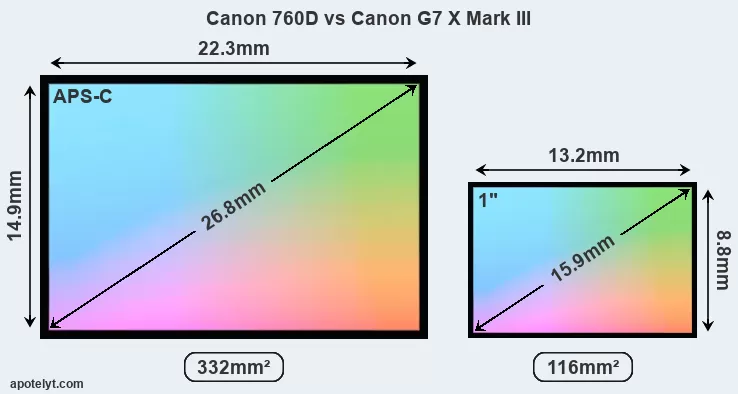
With 24MP, the 760D offers a higher resolution than the G7X Mark III (20MP), but the 760D nevertheless has larger individual pixels (pixel pitch of 3.72μm versus 2.41μm for the G7X Mark III) due to its larger sensor. However, the G7X Mark III is a much more recent model (by 4 years and 5 months) than the 760D, and its sensor will have benefitted from technological advances during this time that further enhance the light gathering capacity of its pixels.
The resolution advantage of the Canon 760D implies greater flexibility for cropping images or the possibility to print larger pictures. The maximum print size of the 760D for good quality output (200 dots per inch) amounts to 30 x 20 inches or 76.2 x 50.8 cm, for very good quality (250 dpi) 24 x 16 inches or 61 x 40.6 cm, and for excellent quality (300 dpi) 20 x 13.3 inches or 50.8 x 33.9 cm. The corresponding values for the Canon G7 X Mark III are 27.4 x 18.2 inches or 69.5 x 46.3 cm for good quality, 21.9 x 14.6 inches or 55.6 x 37.1 cm for very good quality, and 18.2 x 12.2 inches or 46.3 x 30.9 cm for excellent quality prints.
The 760D has on-sensor phase detect pixels, which results in fast and reliable autofocus acquisition even during live view operation.
The Canon EOS 760D has a native sensitivity range from ISO 100 to ISO 12800, which can be extended to ISO 100-25600. The corresponding ISO settings for the Canon PowerShot G7 X Mark III are ISO 125 to ISO 12800, with the possibility to increase the ISO range to 125-25600.
In terms of underlying technology, the 760D is build around a CMOS sensor, while the G7X Mark III uses a BSI-CMOS imager. Both cameras use a Bayer filter for capturing RGB colors on a square grid of photosensors. This arrangement is found in most digital cameras.
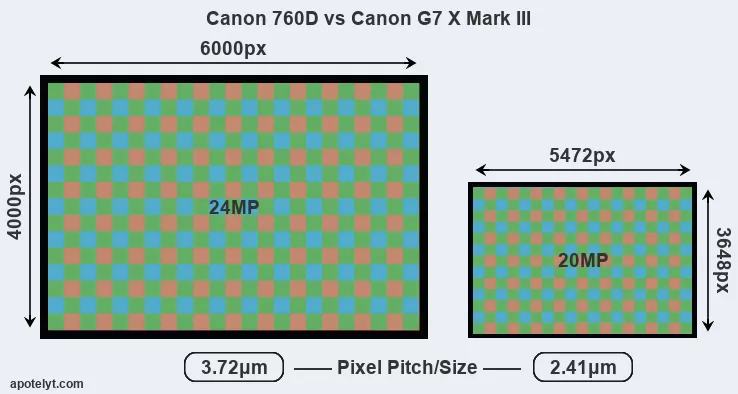
For many cameras, data on sensor performance has been reported by DXO Mark. This service assesses and scores the color depth ("DXO Portrait"), dynamic range ("DXO Landscape"), and low-light sensitivity ("DXO Sports") of camera sensors, and also publishes an overall camera score. The following table provides an overview of the physical sensor characteristics, as well as the sensor quality measurements for a selection of comparators.

| Camera Model |
Sensor Class |
Resolution (MP) |
Horiz. Pixels |
Vert. Pixels |
Video Format |
DXO Portrait |
DXO Landscape |
DXO Sports |
DXO Overall |
||
|---|---|---|---|---|---|---|---|---|---|---|---|
| 1. | Canon 760D | APS-C | 24.0 | 6000 | 4000 | 1080/30p | 22.6 | 12.0 | 915 | 70 | |
| 2. | Canon G7 X Mark III | 1-inch | 20.0 | 5472 | 3648 | 4K/30p | 22.2 | 12.4 | 583 | 65 | |
| 3. | Canon 77D | APS-C | 24.0 | 6000 | 4000 | 1080/60p | 23.6 | 13.3 | 971 | 78 | |
| 4. | Canon 650D | APS-C | 17.9 | 5184 | 3456 | 1080/30p | 21.7 | 11.2 | 722 | 62 | |
| 5. | Canon 750D | APS-C | 24.0 | 6000 | 4000 | 1080/30p | 22.7 | 12.0 | 919 | 71 | |
| 6. | Canon 800D | APS-C | 24.0 | 6000 | 4000 | 1080/60p | 23.7 | 13.1 | 1586 | 80 | |
| 7. | Canon 1200D | APS-C | 17.9 | 5184 | 3456 | 1080/30p | 21.9 | 11.3 | 724 | 63 | |
| 8. | Canon 2000D | APS-C | 24.0 | 6000 | 4000 | 1080/30p | 22.6 | 11.9 | 1009 | 71 | |
| 9. | Canon G1 X Mark II | 1.5-inch | 13.0 | 4160 | 3120 | 1080/30p | 21.5 | 10.8 | 581 | 58 | |
| 10. | Canon G5 X | 1-inch | 20.0 | 5472 | 3648 | 1080/60p | 21.4 | 12.3 | 471 | 62 | |
| 11. | Canon G5 X Mark II | 1-inch | 20.0 | 5472 | 3648 | 4K/30p | 22.2 | 12.4 | 583 | 65 | |
| 12. | Canon G7 X | 1-inch | 20.0 | 5472 | 3648 | 1080/60p | 23.0 | 12.7 | 556 | 71 | |
| 13. | Canon G7 X Mark II | 1-inch | 20.0 | 5472 | 3648 | 1080/60p | 21.8 | 11.9 | 260 | 62 | |
| 14. | Canon M5 | APS-C | 24.0 | 6000 | 4000 | 1080/60p | 23.4 | 12.4 | 1262 | 77 | |
| 15. | Canon SX740 | 1/2.3 | 20.2 | 5184 | 3888 | 4K/30p | 20.6 | 12.1 | 1050 | 51 | |
| 16. | Nikon D5600 | APS-C | 24.0 | 6000 | 4000 | 1080/60p | 24.1 | 14.0 | 1306 | 84 | |
| Note: DXO values in italics represent estimates based on sensor size and age. | |||||||||||
Many modern cameras are not only capable of taking still images, but also of capturing video footage. Both cameras under consideration are equipped with sensors that have a sufficiently high read-out speed for moving images, but the G7X Mark III provides a better video resolution than the 760D. It can shoot movie footage at 4K/30p, while the 760D is limited to 1080/30p.
Feature comparison
Apart from body and sensor, cameras can and do differ across a variety of features. For example, the 760D has an optical viewfinder, which can be very useful when shooting in bright sunlight. In contrast, the G7X Mark III relies on live view and the rear LCD for framing. The following table reports on some other key feature differences and similarities of the Canon 760D, the Canon G7 X Mark III, and comparable cameras.

| Camera Model |
Viewfinder (Type or 000 dots) |
Control Panel (yes/no) |
LCD Specifications (inch/000 dots) |
LCD Attach- ment |
Touch Screen (yes/no) |
Max Shutter Speed * |
Max Shutter Flaps * |
Built-in Flash (yes/no) |
Built-in Image Stab |
||
|---|---|---|---|---|---|---|---|---|---|---|---|
| 1. | Canon 760D | optical | Y | 3.0 / 1040 | swivel | Y | 1/4000s | 5.0/s | Y | n | |
| 2. | Canon G7 X Mark III | none | n | 3.0 / 1040 | tilting | Y | 1/2000s | 30/s | Y | Y | |
| 3. | Canon 77D | optical | Y | 3.0 / 1040 | swivel | Y | 1/4000s | 6.0/s | Y | n | |
| 4. | Canon 650D | optical | n | 3.0 / 1040 | swivel | Y | 1/4000s | 5.0/s | Y | n | |
| 5. | Canon 750D | optical | n | 3.0 / 1040 | swivel | Y | 1/4000s | 5.0/s | Y | n | |
| 6. | Canon 800D | optical | n | 3.0 / 1040 | swivel | Y | 1/4000s | 6.0/s | Y | n | |
| 7. | Canon 1200D | optical | n | 3.0 / 460 | fixed | n | 1/4000s | 3.0/s | Y | n | |
| 8. | Canon 2000D | optical | n | 3.0 / 920 | fixed | n | 1/4000s | 3.0/s | Y | n | |
| 9. | Canon G1 X Mark II | optional | n | 3.0 / 1040 | tilting | Y | 1/4000s | 5.2/s | Y | Y | |
| 10. | Canon G5 X | 2360 | n | 3.0 / 1040 | swivel | Y | 1/2000s | 5.9/s | Y | Y | |
| 11. | Canon G5 X Mark II | 2360 | n | 3.0 / 1040 | tilting | Y | 1/2000s | 30/s | Y | Y | |
| 12. | Canon G7 X | none | n | 3.0 / 1040 | tilting | Y | 1/2000s | 6.5/s | Y | Y | |
| 13. | Canon G7 X Mark II | none | n | 3.0 / 1040 | tilting | Y | 1/2000s | 8.0/s | Y | Y | |
| 14. | Canon M5 | 2360 | n | 3.2 / 1620 | tilting | Y | 1/4000s | 9.0/s | Y | n | |
| 15. | Canon SX740 | none | n | 3.0 / 922 | tilting | n | 1/3200s | 10.0/s | Y | Y | |
| 16. | Nikon D5600 | optical | n | 3.2 / 1037 | swivel | Y | 1/4000s | 5.0/s | Y | n | |
| Note: *) Information refers to the mechanical shutter, unless the camera only has an electronic one. | |||||||||||
One feature that is present on the 760D, but is missing on the G7X Mark III is a top-level LCD. While being, of course, smaller than the rear screen, the control panel conveys some of the essential shooting information and can be convenient for quick and easy settings verification.
Both cameras have an articulated rear screen that can be turned to be front-facing. This feature will be particularly appreciated by vloggers and photographers who are interested in taking selfies.The reported shutter speed information refers to the use of the mechanical shutter. Yet, some cameras only have an electronic shutter, while others have an electronic shutter in addition to a mechanical one. In fact, the G7X Mark III is one of those camera that have an additional electronic shutter, which makes completely silent shooting possible. However, this mode is less suitable for photographing moving objects (risk of rolling shutter) or shooting under artificial light sources (risk of flickering).
The Canon G7 X Mark III has an intervalometer built-in. This enables the photographer to capture time lapse sequences, such as flower blooming, a sunset or moon rise, without purchasing an external camera trigger and related software.
Concerning the storage of imaging data, both the 760D and the G7X Mark III write their files to SDXC cards. Both cameras can use UHS-I cards, which provide for Ultra High Speed data transfer of up to 104 MB/s.
Connectivity comparison
For some imaging applications, the extent to which a camera can communicate with its environment can be an important aspect in the camera decision process. The table below provides an overview of the connectivity of the Canon EOS 760D and Canon PowerShot G7 X Mark III and, in particular, the interfaces the cameras (and selected comparators) provide for accessory control and data transfer.

| Camera Model |
Hotshoe Port |
Internal Mic / Speaker |
Microphone Port |
Headphone Port |
HDMI Port |
USB Port |
WiFi Support |
NFC Support |
Bluetooth Support |
||
|---|---|---|---|---|---|---|---|---|---|---|---|
| 1. | Canon 760D | Y | stereo / mono | Y | - | mini | 2.0 | Y | Y | - | |
| 2. | Canon G7 X Mark III | - | stereo / mono | Y | - | micro | 3.1 | Y | - | Y | |
| 3. | Canon 77D | Y | stereo / mono | Y | - | mini | 2.0 | Y | Y | Y | |
| 4. | Canon 650D | Y | stereo / mono | Y | - | mini | 2.0 | - | - | - | |
| 5. | Canon 750D | Y | stereo / mono | Y | - | mini | 2.0 | Y | Y | - | |
| 6. | Canon 800D | Y | stereo / mono | Y | - | mini | 2.0 | Y | Y | Y | |
| 7. | Canon 1200D | Y | mono / mono | - | - | mini | 2.0 | - | - | - | |
| 8. | Canon 2000D | Y | mono / mono | - | - | mini | 2.0 | Y | Y | - | |
| 9. | Canon G1 X Mark II | Y | stereo / mono | - | - | mini | 2.0 | Y | Y | - | |
| 10. | Canon G5 X | Y | stereo / mono | - | - | mini | 2.0 | Y | Y | - | |
| 11. | Canon G5 X Mark II | - | stereo / mono | - | - | micro | 3.1 | Y | - | Y | |
| 12. | Canon G7 X | - | stereo / mono | - | - | micro | 2.0 | Y | Y | - | |
| 13. | Canon G7 X Mark II | - | stereo / mono | - | - | micro | 2.0 | Y | Y | - | |
| 14. | Canon M5 | Y | stereo / mono | Y | - | mini | 2.0 | Y | Y | Y | |
| 15. | Canon SX740 | - | stereo / mono | - | - | micro | 2.0 | Y | - | Y | |
| 16. | Nikon D5600 | Y | stereo / mono | Y | - | mini | 2.0 | Y | Y | Y |
It is notable that the 760D has a hotshoe, while the G7X Mark III does not. This socket makes it possible to easily attach optional accessories, such as an external flash gun.
The G7X Mark III is a recent model that features in the current product line-up of Canon. In contrast, the 760D has been discontinued (but can be found pre-owned on ebay). As a replacement in the same line of cameras, the 760D was succeeded by the Canon 77D. Further information on the features and operation of the 760D and G7X Mark III can be found, respectively, in the Canon 760D Manual (free pdf) or the online Canon G7 X Mark III Manual.
Review summary
So what is the bottom line? Is the Canon 760D better than the Canon G7 X Mark III or vice versa? The listing below highlights the relative strengths of the two models.
Reasons to prefer the Canon EOS 760D:
- More detail: Offers more megapixels (24 vs 20MP) with a 10% higher linear resolution.
- Better live-view autofocus: Features on-sensor phase-detection for more confident autofocus.
- Easier framing: Has an optical viewfinder for image composition and settings control.
- Easier setting verification: Features an LCD display on top to control shooting parameters.
- More flexible LCD: Has a swivel screen for odd-angle shots in portrait or landscape orientation.
- Faster shutter: Has higher mechanical shutter speed (1/4000s vs 1/2000s) to freeze action.
- More flexible: Can take a variety of interchangeable lenses, including specialty optics.
- Longer lasting: Can take more shots (440 versus 235) on a single battery charge.
- Better lighting: Features a hotshoe and can thus hold and trigger an external flash gun.
- Easier device pairing: Supports NFC for fast wireless image transfer over short distances.
- More heavily discounted: Has been available for much longer (launched in February 2015).
Arguments in favor of the Canon PowerShot G7 X Mark III:
- Better jpgs: Has a more modern image processing engine (DIGIC 8 vs DIGIC 6).
- Better video: Provides higher definition movie capture (4K/30p vs 1080/30p).
- Faster burst: Shoots at higher frequency (30 vs 5 flaps/sec) to capture the decisive moment.
- Less disturbing: Has an electronic shutter option for completely silent shooting.
- Easier time-lapse photography: Has an intervalometer built-in for low frequency shooting.
- Ready to shoot: Comes with an integrated lens, while the 760D requires a separate lens.
- More compact: Is smaller (105x61mm vs 132x101mm) and will fit more readily into a bag.
- Less heavy: Has a lower weight even though it has a lens built in (unlike the 760D).
- Easier travel charging: Can be conveniently charged via its USB port.
- Sharper images: Has stabilization technology built-in to reduce the impact of hand-shake.
- Faster data transfer: Supports a more advanced USB protocol (3.1 vs 2.0).
- Easier wireless transfer: Supports Bluetooth for image sharing without cables.
- More modern: Reflects 4 years and 5 months of technical progress since the 760D launch.
If the count of relative strengths (bullet points above) is taken as a measure, the G7X Mark III emerges as the winner of the match-up (13 : 11 points). However, the pertinence of the various camera strengths will differ across photographers, so that you might want to weigh individual camera traits according to their importance for your own imaging needs before making a camera decision. A professional wedding photographer will view the differences between cameras in a way that diverges from the perspective of a travel photog, and a person interested in cityscapes has distinct needs from a macro shooter. Hence, the decision which camera is best and worth buying is often a very personal one.
How about other alternatives? Do the specifications of the Canon 760D and the Canon G7 X Mark III place the cameras among the top in their class? Find out in the latest Best DSLR Camera and Best Travel-Zoom Camera listings whether the two cameras rank among the cream of the crop.
In any case, while the specs-based evaluation of cameras can be instructive in revealing their potential as photographic tools, it remains partial and cannot reveal, for example, the shooting experience and imaging performance when actually working with the 760D or the G7X Mark III. User reviews that are available, for instance, at amazon can sometimes shed light on these issues, but such feedback is all too often partial, inconsistent, and inaccurate.
Expert reviews
This is why hands-on reviews by experts are important. The following table reports the overall ratings of the cameras as published by some of the major camera review sites (amateurphotographer [AP], cameralabs [CL], digitalcameraworld [DCW], dpreview [DPR], ephotozine [EPZ], photographyblog [PB]). As can be seen, the professional reviewers agree in many cases on the quality of different cameras, but sometimes their assessments diverge, reinforcing the earlier point that a camera decision is often a very personal choice.

| Camera Model |
AP score |
CL score |
DCW score |
DPR score |
EPZ score |
PB score |
Camera Launch |
Launch Price (USD) |
Street Price |
||
|---|---|---|---|---|---|---|---|---|---|---|---|
| 1. | Canon 760D | 5/5 | + | .. | 77/100 | 4.5/5 | 4.5/5 | Feb 2015 | 649 | ebay.com | |
| 2. | Canon G7 X Mark III | .. | + + | 4/5 | 81/100 | 4/5 | .. | Jul 2019 | 749 | amazon.com | |
| 3. | Canon 77D | 4.5/5 | .. | 4/5 | 82/100 | 4.5/5 | 4/5 | Feb 2017 | 899 | ebay.com | |
| 4. | Canon 650D | 4/5 | + + | .. | 77/100 | 4.5/5 | 4.5/5 | Jun 2012 | 849 | ebay.com | |
| 5. | Canon 750D | 5/5 | .. | .. | 75/100 | 4.5/5 | 4.5/5 | Feb 2015 | 749 | ebay.com | |
| 6. | Canon 800D | 4.5/5 | .. | 3.5/5 | 80/100 | 4.5/5 | 4/5 | Feb 2017 | 749 | ebay.com | |
| 7. | Canon 1200D | 3/5 | + | .. | .. | 4/5 | 4.5/5 | Feb 2014 | 449 | ebay.com | |
| 8. | Canon 2000D | 3/5 | o | 3.5/5 | .. | 3.5/5 | 3.5/5 | Feb 2018 | 449 | amazon.com | |
| 9. | Canon G1 X Mark II | 3/5 | + | .. | 77/100 | 4/5 | 4.5/5 | Feb 2014 | 799 | ebay.com | |
| 10. | Canon G5 X | 5/5 | + + | .. | 78/100 | 4.5/5 | 4.5/5 | Oct 2015 | 799 | ebay.com | |
| 11. | Canon G5 X Mark II | 4/5 | + | 4/5 | 82/100 | .. | 4/5 | Jul 2019 | 899 | ebay.com | |
| 12. | Canon G7 X | 4/5 | + + | .. | 77/100 | 4.5/5 | 4.5/5 | Sep 2014 | 699 | ebay.com | |
| 13. | Canon G7 X Mark II | 4.5/5 | + + | .. | 81/100 | 4.5/5 | 4.5/5 | Feb 2016 | 699 | ebay.com | |
| 14. | Canon M5 | 4/5 | + | 4/5 | 82/100 | 4/5 | 4/5 | Sep 2016 | 979 | ebay.com | |
| 15. | Canon SX740 | .. | + | 3.5/5 | .. | 4/5 | 4/5 | Jul 2018 | 399 | amazon.com | |
| 16. | Nikon D5600 | 4/5 | .. | 4/5 | 79/100 | 4.5/5 | 4/5 | Nov 2016 | 699 | ebay.com | |
| Note: (+ +) highly recommended; (+) recommended; (o) reviewed; (..) not available. | |||||||||||
The review scores listed above should be treated with care, though. The ratings were established in reference to similarly priced cameras that were available in the market at the time of the review. Thus, a score needs to be put into the context of the launch date and the launch price of the camera, and comparisons of ratings among very different cameras or across long time periods have little meaning. It should also be noted that some of the review sites have over time altered the way they render their verdicts.

Check 760D offers at
ebay.com

Check G7X Mark III price at
amazon.com
Other camera comparisons
Did this review help to inform your camera decision process? If you would like to see a different side-by-side camera review, just use the search menu below. Alternatively, you can follow any of the listed hyperlinks for comparisons that others found interesting.
- Canon 760D vs Canon 77D
- Canon 760D vs Leica TL
- Canon 760D vs Nikon D60
- Canon 760D vs Panasonic TZ100
- Canon 760D vs Sony RX10 II
- Canon 760D vs Sony RX10 III
- Canon G7 X Mark III vs Canon G9 X
- Canon G7 X Mark III vs Leica V-LUX 4
- Canon G7 X Mark III vs Panasonic G7
- Canon G7 X Mark III vs Panasonic GX800
- Canon G7 X Mark III vs Panasonic ZS100
- Canon G7 X Mark III vs Sony A6700
Specifications: Canon 760D vs Canon G7 X Mark III
Below is a side-by-side comparison of the specs of the two cameras to facilitate a quick review of their differences and common features.
| Camera Model | Canon 760D | Canon G7 X Mark III |
|---|---|---|
| Camera Type | Digital single lens reflex | Fixed lens compact camera |
| Camera Lens | Canon EF mount lenses | 24-100mm f/1.8-2.8 |
| Launch Date | February 2015 | July 2019 |
| Launch Price | USD 649 | USD 749 |
| Sensor Specs | Canon 760D | Canon G7 X Mark III |
| Sensor Technology | CMOS | BSI-CMOS |
| Sensor Format | APS-C Sensor | 1" Sensor |
| Sensor Size | 22.3 x 14.9 mm | 13.2 x 8.8 mm |
| Sensor Area | 332.27 mm2 | 116.16 mm2 |
| Sensor Diagonal | 26.8 mm | 15.9 mm |
| Crop Factor | 1.6x | 2.7x |
| Sensor Resolution | 24 Megapixels | 20 Megapixels |
| Image Resolution | 6000 x 4000 pixels | 5472 x 3648 pixels |
| Pixel Pitch | 3.72 μm | 2.41 μm |
| Pixel Density | 7.22 MP/cm2 | 17.18 MP/cm2 |
| Moiré control | Anti-Alias filter | Anti-Alias filter |
| Movie Capability | 1080/30p Video | 4K/30p Video |
| ISO Setting | 100 - 12,800 ISO | 125 - 12,800 ISO |
| ISO Boost | 100 - 25,600 ISO | 125 - 25,600 ISO |
| Image Processor | DIGIC 6 | DIGIC 8 |
| DXO Sensor Quality (score) | 70 | .. |
| DXO Color Depth (bits) | 22.6 | .. |
| DXO Dynamic Range (EV) | 12.0 | .. |
| DXO Low Light (ISO) | 915 | .. |
| Screen Specs | Canon 760D | Canon G7 X Mark III |
| Viewfinder Type | Optical viewfinder | no viewfinder |
| Viewfinder Field of View | 95% | |
| Viewfinder Magnification | 0.51x | |
| Top-Level Screen | Control Panel | no Top Display |
| LCD Framing | Live View | Live View |
| Rear LCD Size | 3.0inch | 3.0inch |
| LCD Resolution | 1040k dots | 1040k dots |
| LCD Attachment | Swivel screen | Tilting screen |
| Touch Input | Touchscreen | Touchscreen |
| Shooting Specs | Canon 760D | Canon G7 X Mark III |
| Focus System | Phase-detect AF | Contrast-detect AF |
| Manual Focusing Aid | no Peaking Feature | Focus Peaking |
| Max Shutter Speed (mechanical) | 1/4000s | 1/2000s |
| Continuous Shooting | 5 shutter flaps/s | 30 shutter flaps/s |
| Electronic Shutter | no E-Shutter | up to 1/25600s |
| Time-Lapse Photography | no Intervalometer | Intervalometer built-in |
| Fill Flash | Built-in Flash | Built-in Flash |
| Storage Medium | SDXC cards | SDXC cards |
| Single or Dual Card Slots | Single card slot | Single card slot |
| UHS card support | UHS-I | UHS-I |
| Connectivity Specs | Canon 760D | Canon G7 X Mark III |
| External Flash | Hotshoe | no Hotshoe |
| USB Connector | USB 2.0 | USB 3.1 |
| HDMI Port | mini HDMI | micro HDMI |
| Microphone Port | External MIC port | External MIC port |
| Wifi Support | Wifi built-in | Wifi built-in |
| Near-Field Communication | NFC built-in | no NFC |
| Bluetooth Support | no Bluetooth | Bluetooth built-in |
| Body Specs | Canon 760D | Canon G7 X Mark III |
| Battery Type | Canon LP-E17 | Canon NB-13L |
| Battery Life (CIPA) | 440 shots per charge | 235 shots per charge |
| In-Camera Charging | no USB charging | USB charging |
| Body Dimensions |
132 x 101 x 78 mm (5.2 x 4.0 x 3.1 in) |
105 x 61 x 41 mm (4.1 x 2.4 x 1.6 in) |
| Camera Weight | 565 g (19.9 oz) | 304 g (10.7 oz) |

Check 760D offers at
ebay.com

Check G7X Mark III price at
amazon.com
Did you notice an error on this page? If so, please get in touch, so that we can correct the information.
